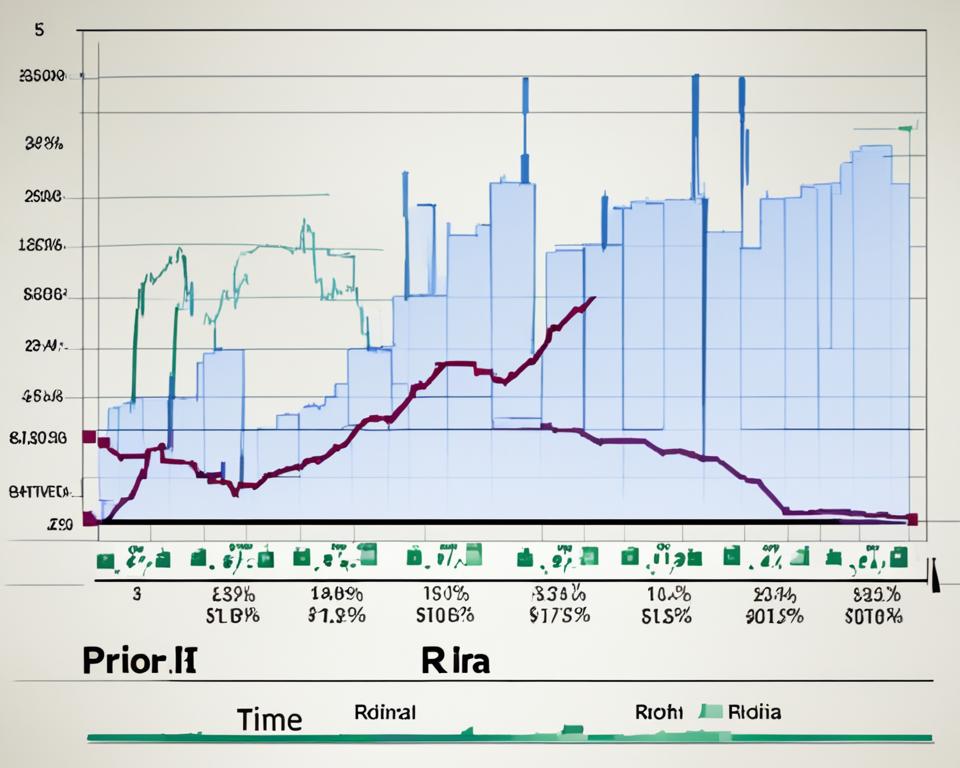Embarking on your retirement journey can be filled with financial forks in the road, prompting the question: are dividend stocks good for Roth IRA investment strategies? The allure of tax-free income later in life makes Roth IRA dividend stocks an enticing option for many savvy savers. If you’re contemplating investing in dividend stocks for Roth IRA purposes, you’re looking at the potential to compound gains while bypassing the taxman upon retirement—a tempting prospect for anyone striving for fiscal security.
As you dive into the world of IRAs, understanding the unique benefits of combining the power of dividends with the tax advantages of a Roth IRA could significantly impact the growth of your long-term savings. Whether you’re a seasoned investor or just starting, it’s essential to align your retirement plan with investments that cater to your financial goals and provide a steady stream of income when you’re ready to relax and enjoy the golden years.
Let’s explore how a Roth IRA can serve as a robust vehicle for housing your dividend investments and what this could mean for your financial future. With the right approach, your retirement account may not just be good—it could flourish.
Key Takeaways
- Roth IRAs offer tax-free growth and distributions, making them ideal for dividend investing.
- Understanding the differences between a Roth and Traditional IRA is key to tailoring your retirement plan.
- Investing in dividend stocks within a Roth IRA can significantly bolster your retirement savings.
- Dividend stocks can provide a steady income stream in retirement, free from tax burdens.
- Staying informed about contribution limits and regulations will optimize the benefits of your Roth IRA.
- Consistent reinvestment of dividends can harness the power of compounding for long-term wealth creation.
Understanding Roth IRAs and Dividend Stocks
As you navigate the retirement landscape, it’s invaluable to understand how certain investments within a Roth IRA can work to your advantage. Specifically, the incorporation of dividend stocks into your Roth IRA investments can be a game-changer, leveraging the unique benefits of dividend stocks in Roth IRA setups. Delving into the mechanics of a Roth IRA and the role dividends play in retirement planning, you’ll find actionable insights to establish a robust portfolio geared towards your golden years.
The Definition and Mechanics of a Roth IRA
A Roth IRA stands out as a retirement savings haven where you contribute post-tax dollars, resulting in one of its most appealing features: tax-free distributions. This fundamental difference sets it apart from Traditional IRAs, which offer immediate tax breaks on contributions but then tax distributions upon withdrawal. With a Roth IRA, you enjoy the fruits of Roth IRA contributions without worrying about the tax implications during your retirement years—an attractive benefit if you expect to be in a higher tax bracket down the line.
Why Dividends Matter in Retirement Planning
Dividends are more than just periodic payments; they’re a cornerstone of retirement planning for many. A strategic approach to these stocks within your Roth IRA helps leverage the power of compounding interest, allowing you to reinvest dividends to further fuel growth. The combination of share price appreciation and dividend payouts contribute to this growth, culminating in a sizable asset base over time. More importantly, within the tax-advantaged environment of a Roth IRA, this wealth accumulation occurs unencumbered by taxes, optimizing your long-term investments for a comfortable retirement.
| Investment Type | Contribution Characteristics | Benefits in Retirement |
|---|---|---|
| Traditional IRA | Pre-tax contributions; taxable distributions | Immediate tax relief; deferred taxation until retirement |
| Roth IRA | Post-tax contributions; tax-free distributions | Enables tax-free growth; free from future tax rates |
| Dividend Stocks in Roth IRA | Taxable capital invested and reinvested dividends | Tax-free withdrawals; compounded growth over time |
By focusing on the benefits of dividend stocks in Roth IRA accounts and the straightforward nature of Roth IRA contributions and investments, you’re setting the stage for not just a retirement fund but a lasting legacy of wealth that can sustain your lifestyle and beyond. Understanding how these components work collectively empowers you to make informed decisions in constructing a retirement strategy that truly reflects your financial aspirations.
Are Dividend Stocks Good for Roth IRA?
When you’re plotting the course for your golden years, the question of “are dividend stocks good for Roth IRA” investments might come up. The short answer is, they can be a remarkably effective component of your retirement plan. A Roth IRA offers a unique tax advantage—contributions are made with after-tax income, but the rewarded dividends grow tax-free and are not taxed upon withdrawal, making them an attractive addition to your retirement strategy.
Let’s take a closer look at why investors often include dividend stocks as part of their Roth IRA portfolio. The main allure is the promise of tax-free income during retirement. The ability to reinvest dividends to compound wealth within a Roth IRA allows for a critical growth strategy in the long run. This compounding effect, combined with the tax exemption, means your invested capital potentially balloons over time without the drag of taxes that would otherwise be payable in a non-retirement investment account.
For those seeking the best dividend stocks for Roth IRA, the focus usually turns to securities that not only offer robust dividend payouts but also demonstrate stability and consistent growth. The rationale behind selecting dividend-paying equities lies in their dual role as income generators and as means to bolster the investment’s overall value through re-investment and compound interest.
So, should you make a beeline for dividend stocks when tailoring your Roth IRA? Your decision hinges on your individual retirement goals and the alignment of those goals with the tax-friendly nature of a Roth IRA. If you foresee a retirement filled with financial security and one less worry about taxes, dividend stocks within a Roth IRA can serve as sturdy pillars supporting your future financial edifice.
- Tax-free growth and withdrawals in Roth IRA boost the impact of dividend reinvestments.
- Dividend-paying equities are a worthy consideration for long-term retirement planning.
- Choosing dividend stocks revolves around the anticipation of a secure and tax-efficient income stream in retirement.
Remember, like any investment decision, the key to using Roth IRA for dividend stocks rests in due diligence. You want to ensure that your portfolio comprises investments that align well with your fiscal expectations and provide an enclave for your assets to flourish, shielded from the rigors of tax implications. Ultimately, navigating the prospects of a Roth IRA enriched with dividends necessitates a blend of savvy selection and a keen eye on the long horizon of your retirement goals.
The Advantages of Holding Dividend Stocks in Your Roth IRA
Roth IRA investing in dividend stocks carries a unique set of benefits that cater to the forward-thinking investor. Specifically, the strategic allocation of dividend-paying equities within this tax-advantaged account may be a wise move for those looking to maximize their retirement assets. Herein lies an exploration of how such assets can contribute to a more prosperous financial future.
First, let’s dissect the appeal of dividend stocks within a Roth IRA. When mapping out your long-term financial journey, stocks that pay dividends can serve as powerful vehicles to drive your portfolio’s growth and provide welcome financial security during retirement.
Compounding Growth with Tax-Free Dividends
One of the most compelling arguments for holding dividend stocks in your Roth IRA is the ability to facilitate compounding interest. The reason is simple: the dividends you earn from these stocks are not taxed, thereby allowing you to reinvest the full breadth of your earnings back into the market, which could then yield even more dividends.
Imagine planting a tree whose seeds—dividends in this analogy—can be sown repetitively without relinquishing a portion of each harvest to taxes. Over time, this cycle engenders a lush financial forest, where each tree represents an investment that has reached maturity without the constraints of regular taxes diminishing its potential.
This tax-free reinvestment is pivotal as it accentuates the growth potential within your Roth IRA, setting the stage for a vigorous compounding effect that can significantly bulk up your retirement fund.
Building a Stable Income Stream for Retirement
Another merits of incorporating dividend stocks into your Roth IRA is the prospect of building a stable income stream. The path to retirement can be walked with greater confidence when your steps are cushioned by the promise of consistent, tax-free distributions.
This stable income is a result of deliberate investments in companies that not only have a history of regular dividend payouts but also showcase strong potential for sustained performance and dividend growth. By doing so, you amass an arsenal of financial assets within your Roth IRA that stand ready to serve you when you retire—like having a well-stocked pantry to rely on in your time of leisure.
Combining the tax-free growth benefits of a Roth IRA with a portfolio of robust dividend stocks facilitates an environment where your money can thrive unfettered by taxing concerns, providing peace of mind that your retirement years are financially secure.
Ultimately, these factors make Roth IRA the ideal vault for your dividend-yielding investments. As long as you follow the rules laid out by the IRA guidelines, such as the age and distribution conditions, your investments can potentially flourish, providing you with the financial stability you’ve worked so diligently to achieve.
- Tax-efficient compounding interest bolsters your retirement savings.
- Dividend stocks within Roth IRA offer growth and income benefits.
When you’re picturing your ideal retirement, imagine it with the enhanced growth and stability provided by dividend stocks in your Roth IRA. By tapping into this strategy, you’re leveraging tax-efficiency for an easier tomorrow.
Examination of Best Dividend Stocks for Roth IRA
When it comes to enhancing your retirement portfolio, finding the top dividend stocks for Roth IRA can be a pivotal move. As you journey towards a financially secure retirement, dividends are not just a perk, but can become a cornerstone of your investment strategy. To this end, the spotlight falls on blue-chip companies renowned for their resilient performance and reliable dividend yield. It’s not simply a matter of picking stocks with the highest dividends, but rather selecting those that promise sustainability and growth.
Identifying High-Quality Dividend Stocks
Identifying high-quality dividend stocks demands a discerning approach, focusing on firms with an established track record of both stability and dividend consistency. The investment landscape brims with opportunities, but your aim should be on blue-chip companies that have stood the test of time. These pillars of the stock market offer not only reliable dividend payouts but are often leaders in their respective industries, bringing a sense of security to your investment.
Here are some factors to consider when scouting for such stocks for your Roth IRA:
- A history of robust and consistent dividend payments.
- Financial strength and the ability to maintain dividend payouts during economic downturns.
- Management with a shareholder-friendly approach, prioritizing returns to investors.
Focusing on these qualities can lead you toward securing assets that provide both immediate income and long-term growth potential for your retirement years.
Assessing Dividend Sustainability
While tempting, a high dividend yield should not be the sole factor in your decision-making process. It’s essential to appraise the dividend’s sustainability, which hinges on the company’s long-term financial health. Look beyond the yield and scrutinize the payout ratio—the percentage of earnings paid out as dividends. A ratio that’s too high could signal trouble ahead, potentially leading to reduced payouts or, worse, dividend cuts.
Analyze these aspects to determine a stock’s dividend sustainability:
- The company’s earnings growth and its ability to cover dividend payments.
- The stability of the company’s business model in the face of market fluctuations.
- The industry in which the company operates, considering whether it’s prone to volatile cycles that could impact dividends.
By considering these elements, you will be poised to choose stocks that are more likely to provide a steady stream of income for your Roth IRA, mitigating risks and setting the stage for potential financial comfort in your later years.
Continuing the evaluation of your potential picks, it’s prudent to compile data on the stocks you’re considering. Below, we’ve put together a table contrasting several well-known blue-chip stocks with their respective dividend yields, providing a snapshot of their appeal as long-term retirement investments.
| Company | Dividend Yield | Payout Ratio | 5-Year Dividend Growth |
|---|---|---|---|
| Johnson & Johnson | 2.5% | 46% | 6% per year |
| 3M | 3.3% | 58% | 5.7% per year |
| Coca-Cola | 3.1% | 70% | 3.2% per year |
| Disney | 1.2% | 28% | 4.8% per year |
In conclusion, it’s the combination of high dividend yield, a reasonable payout ratio, and positive dividend growth that often heralds the best dividend stocks for Roth IRA. By selecting these stocks wisely, you’re paving a path towards a retirement portfolio that not only sustains but also potentially expands, ensuring that your golden years are as golden as can be.
Maximizing Roth IRA Potential Through Dividend Investing
Building a Roth IRA with dividend stocks is akin to sowing the seeds of fiscal growth, nurturing the soil of your investments with strategic choices and a future-centric mindset. The astute investor recognizes the twin pillars of longevity and resilience in dividend-paying assets, especially when such assets populate the fertile ground of a Roth IRA. Here’s how you can align the mechanics of dividend investing with the tax-efficient contours of a Roth IRA to amplify your retirement savings.
The Significance of Reinvestment of Dividends
Picture the dividend as a perennial spring, flowing back into the river of your investment portfolio. The choice to reinvest dividends can transform gentle streams into a powerful financial current over time, leveraging the miraculous effect of compounding. Every reinvested dividend buys more shares, generating additional dividends, cascading into a larger asset pool without the encumbrance of taxes.
A compound interest calculator becomes an investor’s telescope, projecting the potential earnings over the voyage of your career into the realm of retirement. With each reinvestment, the calculator’s figures morph, evidencing the tangible impact of consistent strategies on your Roth IRA’s growth trajectory.
Strategies for Long-Term Wealth Accumulation
In the chess game of retirement planning, the right moves lead to checkmate against financial insecurity. To build a Roth IRA that stands as your stronghold, you must convene the mighty Dividend Aristocrats onto your playing field. These esteemed companies have declared and increased their dividends for a minimum of 25 consecutive years, showcasing economic fortitude and a proclivity for shareholder enrichment.
In the long term, the knight’s move for wealth accumulation is selecting a diversified array of Dividend Aristocrats for your Roth IRA. Investment in such companies assures a steady climb in share value and an increment in dividends, a sinew of financial strength as you tread into retirement. This astute approach to building your portfolio ensures the golden years shine with the luster of wise dividend investing.
Engaging in dividend investing within a Roth IRA is not just about securing a seat at the table of prosperity; it’s claiming a banquet of tax-efficient growth and deep-rooted gains. The dividends that seed your financial garden today, when faithfully reinvested, become the robust oaks sheltering your tomorrow. Embrace the strategies that steer you towards a future where you reap the rewards of a well-harvested Roth IRA.
The Tax Implications of Dividend Investing in Roth IRAs
Delving into the tax aspects of Roth IRAs reveals why they’re a standout choice for dividend-savvy investors seeking retirement tax benefits. Unlike their Traditional IRA counterparts, Roth IRAs offer a unique feature: tax-free distributions. This key advantage can have a significant impact on your post-retirement finances. But understanding when and how these tax benefits apply is crucial to maximizing your Roth IRA’s potential.
Evaluating the Tax-Free Growth Benefit
The growth of your investments within a Roth IRA, including dividends from stocks, is not just tax-deferred; it’s entirely tax-free. This means you can reinvest your dividends—a process that would normally trigger tax events in taxable accounts—without worrying about the tax implications each year. Your Roth IRA distributions, when the time comes, can be a source of tax-free income, provided you have adhered to the rules laid out by the IRS.
Why is this significant for you? Tax-free growth coupled with reinvestment can significantly accelerate the value of your retirement portfolio, thanks to the power of compounding. The investments in your Roth IRA, shielded from tax erosion, can potentially amass a considerable sum over the years—funds that you can use in retirement without sharing a cut with the tax collector.
Understanding the Five-Year Rule for Tax-Free Withdrawals
A key facet of receiving tax-free distributions from your Roth IRA hinges on the Five-Year Rule. It requires your Roth IRA to be at least five years old, starting from the tax year for your first contribution, before earnings can be withdrawn tax-free. Furthermore, to withdraw earnings without taxes or penalties, you must be over 59.5 years old, or the distributions must meet other certain exceptions, such as being used for a first-time home purchase or due to disability.
This rule ensures that your Roth IRA is geared towards long-term retirement planning, rather than being a short-term investment vehicle. By fulfilling these conditions, you lock in the retirement tax benefits that make Roth IRAs an attractive choice for housing your dividend investments.
To illustrate these long-term benefits, let’s visualize a simple table that breaks down the advantages of Roth IRA’s tax-implication rules:
| Feature | Roth IRA Benefit | Impact on Investor |
|---|---|---|
| Tax-Free Growth | Investments grow without tax | Compounding effect maximized |
| Five-Year Rule | Withdrawals are tax-free after 5 years | Full benefit of investments upon withdrawal |
| Age Consideration | No taxes after age 59.5 | Retirement income is not reduced by taxes |
Understanding and navigating the tax implications of Roth IRAs can empower you to make prudent decisions concerning your retirement savings. With clear insights on tax-free distributions and the importance of adhering to the Five-Year Rule, you’re better equipped to plan for a financially stable retirement with Roth IRA distributions forming a vital part of your income stream—ensuring that the benefits of your investment decisions carry through to your golden years.
Comparison: Roth IRA vs. Traditional IRA for Dividend Investing
As an investor looking towards retirement, understanding the distinct features of Roth IRA and Traditional IRA is essential, especially when considering dividend stocks for retirement in Roth IRA. These accounts have unique implications for your retirement strategy, influenced by their respective Roth IRA contribution limits and Traditional IRA withdrawal taxes.
Contribution Limits and Tax Deduction Variables
When it comes to contributions, Roth IRAs and Traditional IRAs play by different rules. With a Traditional IRA, contributions may reduce your taxable income, providing an immediate tax benefit. However, this advantage comes with the caveat that withdrawals in retirement will be taxed as regular income.
Roth IRAs, conversely, offer a longer-term tax benefit. Your contributions are made with after-tax dollars, meaning there’s no tax deduction in the year of contribution. But the payoff comes later, as withdrawals, including those from dividend stocks for retirement in Roth IRA, are completely tax-free, assuming you meet certain conditions.
| Account Type | Contribution | Tax Deduction | Withdrawal Taxes |
|---|---|---|---|
| Traditional IRA | Pre-tax dollars | Yes | Taxed as income |
| Roth IRA | After-tax dollars | No | Tax-free |
Each year, the IRS sets Roth IRA contribution limits and these can change. For both IRA types, there are also phaseouts based on income—higher earning investors may find their contribution capacity reduced or eliminated.
Withdrawing Funds: Age and Timing Considerations
The concept of retirement is synonymous with taking a step back and enjoying the fruits of your labor. To that end, both IRAs consider age 59.5 as the magic number to start withdrawing funds without incurring penalties. But there are nuances. For a Traditional IRA, Required Minimum Distributions (RMDs) must begin at age 72, adding a layer of complexity and potentially unwanted taxable income if you’re not in need of these funds.
Roth IRAs, on the other hand, do not mandate RMDs, granting you more control over your assets. This can be particularly advantageous if your Roth IRA houses dividend stocks for retirement, as it allows your investments to potentially grow tax-free for a longer period.
| Account Type | Premature Withdrawal Penalty | RMDs Requirement |
|---|---|---|
| Traditional IRA | 10% before age 59.5 | Yes, starting at age 72 |
| Roth IRA | 10% before age 59.5 (on earnings) | No |
The decision between a Roth and Traditional IRA for your dividend stocks can be complex, factoring in current tax rates, expected tax rates at retirement, and how heavily you weight the value of tax-deferred growth. Several resources, including Dividend.com’s Retirement Center, can be instrumental in guiding this choice.
Regardless of whether you opt for a Traditional IRA with its immediate tax perks or a Roth IRA with tax-free retirements benefits, factoring in Traditional IRA withdrawal taxes and Roth IRA contribution limits is paramount. Your choice will lay the foundation of your retirement planning and determine how dividend investing can best serve your long-term aspirations.
Real-Life Success Stories of Roth IRA Dividend Investors
The investment landscape is awash with narratives of individuals who have masterfully navigated the vicissitudes of the market to build impressive fortunes. Central to many of these success stories are dividend reinvestment plans (DRIPs), which have demonstrated their capacity to be major players in the realm of wealth accumulation. By allowing investors to systematically reinvest their dividends into additional shares, DRIPs have underscored the transformative power of compound growth, particularly within the tax-advantaged confines of Roth IRAs.
Focus your gaze on the Dividend Aristocrats, an elite group of companies known for their robust and consistent dividend payouts over decades. These success stories often involve investing in blue-chip stocks like Coca-Cola and Johnson & Johnson. These corporations exemplify steadfast growth and shareholder commitment, setting a stage where patient, long-term investors are rewarded handsomely, often reaching the zenith of becoming millionaires solely through the fruits of their dividends.
As you ponder your own financial trajectory, consider these anecdotes not as distant tales, but as blueprints for what’s achievable. The philosophy is simple yet profound: deliberate, long-term investments in dividend-yielding stocks, particularly within a Roth IRA, can be the cornerstone for a solid retirement plan. Let the triumphs of past investors inspire your strategies and be reminded that with commitment and sagacity, your portfolio’s growth could very well become the next testament to the success of astute financial planning.
FAQ
Are dividend stocks good for a Roth IRA?
Yes, dividend stocks can be a good choice for a Roth IRA because dividends grow tax-free and are not taxed upon withdrawal, assuming the account has been open for at least five years and you are over age 59.5 at withdrawal. This can make dividend stocks particularly powerful when using a Roth IRA for retirement planning.
What are the benefits of holding dividend stocks in a Roth IRA?
The primary benefits of holding dividend stocks in a Roth IRA include the tax-free growth of dividends, the ability to reinvest dividends without immediate tax consequences, and the opportunity for these reinvested dividends to compound over time. This can potentially result in a larger, tax-free income stream during retirement.
How do Roth IRA contributions and investments work with dividend stocks?
Contributions to a Roth IRA are made with after-tax dollars, and the investments within the IRA, including dividend stocks, grow tax-free. When you invest in dividend stocks within a Roth IRA, the dividends paid out by the stocks can be reinvested, which may lead to further growth of your investment without the drag of taxes.
What should I look for when choosing the best dividend stocks for my Roth IRA?
When choosing dividend stocks for your Roth IRA, look for companies with a strong history of dividend payments, preferably companies that have consistently raised their dividends over time. These are often blue-chip companies with stable business models and solid financials. A high dividend yield is also attractive, but it should not be the sole factor in your decision-making process.
How do dividends in a Roth IRA contribute to compounding growth?
Dividends in a Roth IRA can significantly contribute to compounding growth because you have the option to automatically reinvest them to purchase more shares of the dividend-paying stock. As your share count increases, so do your subsequent dividends, which leads to a compounding effect over time, potentially increasing the overall value of your investment.
Can you explain the difference between Traditional IRA and Roth IRA withdrawal rules for dividend investing?
Traditional IRA withdrawals are taxed as regular income and required minimum distributions must start at age 72. For Roth IRAs, withdrawals are tax-free if the account is at least five years old and you are over age 59.5 at the time of withdrawal. Additionally, Roth IRAs do not have required minimum distributions during the account owner’s lifetime.
What are the tax implications of dividend investing in a Roth IRA?
The tax implications are predominantly favorable when investing in dividends within a Roth IRA. Since the account is funded with after-tax dollars, dividends and the growth on investments are not taxed when distributed, providing the account has been open for a minimum of five years and withdrawals are made at the qualifying age.
Are Dividend Aristocrats good choices for Roth IRAs?
Dividend Aristocrats, which are companies with a history of increasing their dividends annually for at least 25 years, can be excellent choices for Roth IRAs. These companies have typically demonstrated resilience, reliability, and a commitment to shareholder returns, making them potentially beneficial for long-term growth and income strategies in Roth IRAs.
How does a Roth IRA’s five-year rule affect tax-free withdrawals of dividends?
The five-year rule stipulates that an account must be open for at least five years before earnings, including dividends, can be withdrawn tax-free, provided the withdrawal is qualified. This is to ensure that the Roth IRA serves its purpose as a long-term retirement savings vehicle, rather than immediate tax-free income.
Can you provide success stories of investors with dividend stocks in their Roth IRA?
While specific success stories of individuals should be approached with confidentiality in mind, there are numerous examples of investors who have benefited from dividend reinvestment plans (DRIPs) and patient, long-term investing strategies in blue-chip and Dividend Aristocrat stocks within Roth IRAs, contributing to their wealth going into retirement.












